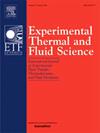甲醇在放大喷油器内的空化模式及近场喷射特性实验研究
IF 3.3
2区 工程技术
Q2 ENGINEERING, MECHANICAL
Experimental Thermal and Fluid Science
Pub Date : 2025-09-26
DOI:10.1016/j.expthermflusci.2025.111624
引用次数: 0
摘要
甲醇作为一种清洁燃料,特别是由绿色电力和回收二氧化碳合成的甲醇,具有零碳潜力,越来越受到关注。然而,由于甲醇的腐蚀性和独特的物理性质,为甲醇发动机设计高压喷油器带来了许多挑战。本研究首次采用放大光学喷嘴对甲醇的流动特性和近场喷雾行为进行了全面分析。采用圆形和尖形喷嘴分别研究了涡致柱状空化和几何致片状空化。通过调整注射针升程和注射压力,研究了甲醇中各种空化模式的发生和发展。此外,还进行了甲醇和柴油的对比实验,分析了不同空化制度下甲醇的流动和喷雾特性的差异,为在发动机中使用甲醇替代柴油提供了见解。实验结果表明,甲醇较低的粘度促进了溶解气体的析出,形成自由气泡积聚在涡核中,从而增强了串的空化作用。在相同工况下,甲醇比柴油表现出更强的空化倾向和更大的空化强度。相比之下,甲醇和柴油在几何诱导空化强度上的差异相对较小,这是由于甲醇对燃料特性变化的响应不太敏感。本文章由计算机程序翻译,如有差异,请以英文原文为准。
Experimental study on cavitation pattern and near-field spray characteristics of methanol in the scaled-up fuel injection nozzle
Methanol, as a clean fuel, particularly when synthesized from green electricity and recycled CO2, has zero-carbon potential and is gaining increasing attention. However, due to methanol’s corrosivity and unique physical properties, designing high-pressure injectors for methanol engines presents numerous challenges. This study presents the first comprehensive analysis of methanol’s flow characteristics and near-field spray behavior using a scaled-up optical nozzle. Rounded and sharp nozzles were used to investigate vortex-induced string cavitation and geometry-induced sheet cavitation. By adjusting the needle lift and injection pressure, the onset and development of various cavitation patterns in methanol were studied. Additionally, comparative experiments between methanol and diesel were conducted to analyze the differences in flow and spray characteristics under different cavitation regimes, providing insights for the use of methanol as a replacement for diesel in engines. Experimental results show that methanol’s lower viscosity promotes the exsolution of dissolved gases, forming free gas bubbles that accumulate in the vortex core, thereby enhancing string cavitation. Under identical operating conditions, methanol exhibits a stronger tendency for string cavitation and greater cavitation intensity compared to diesel. In contrast, the difference in geometric-induced cavitation intensity between methanol and diesel is relatively small, attributed to methanol’s less sensitive response to variations in fuel properties.
求助全文
通过发布文献求助,成功后即可免费获取论文全文。
去求助
来源期刊

Experimental Thermal and Fluid Science
工程技术-工程:机械
CiteScore
6.70
自引率
3.10%
发文量
159
审稿时长
34 days
期刊介绍:
Experimental Thermal and Fluid Science provides a forum for research emphasizing experimental work that enhances fundamental understanding of heat transfer, thermodynamics, and fluid mechanics. In addition to the principal areas of research, the journal covers research results in related fields, including combined heat and mass transfer, flows with phase transition, micro- and nano-scale systems, multiphase flow, combustion, radiative transfer, porous media, cryogenics, turbulence, and novel experimental techniques.
 求助内容:
求助内容: 应助结果提醒方式:
应助结果提醒方式:


